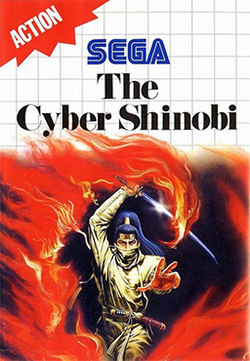Software:The Cyber Shinobi
| The Cyber Shinobi | |
|---|---|
 European cover art | |
| Developer(s) | Sega |
| Publisher(s) | Sega |
| Composer(s) | Keisuke Tsukahara Sheriko Dama |
| Series | Shinobi |
| Platform(s) | Master System |
| Release | April 1990 |
| Genre(s) | Platform, hack and slash |
| Mode(s) | Single-player |
The Cyber Shinobi (also known as Shinobi Part 2) is a side-scrolling hack and slash produced by Sega that was released for the Master System in 1990. It was the third Shinobi game for the console (including Alex Kidd in Shinobi World) and served as a futuristic sequel to the original Shinobi. The game was released in Canada, Europe, Australia and Brazil, at a time when the Master System was discontinued in other markets.
Gameplay
The controls and rules of the game are very different from the original Shinobi. Although the objective of the game is still to reach the end of the stage and then fight a boss, the player is prevented from proceeding onwards at certain points of each stage until certain enemies are eliminated, similar to a side-scrolling beat-'em-up.
The player attacks primarily with their sword and a crouching kick. The height of the player's jumps can be increased as well by holding the d-pad upwards while pressing the jump button. The player has a total of four gauges on the top screen. In addition to their "life" gauge that shows the amount of damage the player can sustain before losing a life, there is also a "power" gauge that determines the strength of their basic attacks, a "shot" gauge that shows the remaining ammunition of their current sub-weapon, and a "Ninjutsu" gauge that determines which spells the player can use. By destroying item containers located throughout each stage, the player can pick up power-ups marked by the letters "L", "P", "S" and "N" to fill out each individual gauge by one unit.
When the player first picks up a "Shot" power-up, they will wield a shuriken launcher, which can be replaced with an automatic "Vulcan" gun, and then a supply of grenades, by picking up subsequent "shot" power-ups. Each sub-weapon can only hold up to eight shots each and when the player's current sub-weapon runs out of ammo, they will revert to the previous one and so-on until their last sub-weapon runs out as well.
"Ninjutsu" spells are performed by pressing buttons '1' and '2' simultaneously. There are a total of four Ninjutsu spells and, although each one requires a different number of units to perform, only two units are actually consumed when one is performed. As a result, the player can max out their Ninjutsu gauge, use the powerful spell, and then work their way down to the weaker ones. The Ninjutsu spells available are "Fire" (requires one or two units), "Tornado" (four units), "Lightning" (six units) and "Earth Element" (eight units).
Graphics: The game featured 8-bit visuals with a colorful palette. Character designs were detailed within hardware limitations. Environments like a construction site, harbor, heliport, jungle, waterfall, and enemy hideout added visual variety.
Sound: Utilized the distinctive sound chip of the Sega Master System. Chiptune melodies and sound effects adapted to gameplay intensity. Sound effects, such as sword slashes and ability activations, enhanced player engagement. Aimed for an immersive experience within technical constraints.
Plot
Set sometime during the 21st century, the player controls the grandson of the ninja master Joe Musashi, also named Joe, who is on a mission to defeat the minions of Cyber-Zeed, a terrorist organization founded by the remnants of the Zeed organization that the original Joe Musashi destroyed. Joe must fight his way through a series of six stages in order to prevent Cyber-Zeed from launching its stolen stockpiles of plutonium around the world. The stages consist of a construction site, a harbor, a heliport, a jungle, a waterfall, and the enemy's hideout.
Reception
| Reception | ||||||||
|---|---|---|---|---|---|---|---|---|
| ||||||||
The game was rated 68 out of a 100 by Sega Pro, which criticized it for its lack of content and easy difficulty.[2] Richard Leadbetter gave the game a score of 46% and compared it unfavorably to the Master System version of the original Shinobi.
References
- ↑ "Cyber Shinobi - Sega Review". Mean Machines (5): 126. February 1991. https://archive.org/details/mean-machines-magazine-05/page/n71/mode/2up.
- ↑ The Profile. Paragon Publishing. April 1993. pp. 70. https://archive.org/details/segapro18/page/n69/mode/2up.
External links
- The Cyber Shinobi at MobyGames
- The Cyber Shinobi can be played for free in the browser at the Internet Archive
 |

